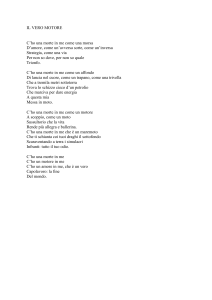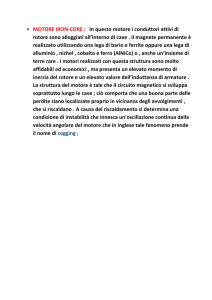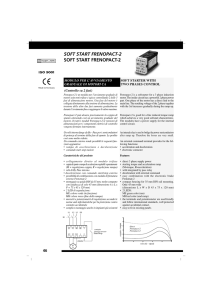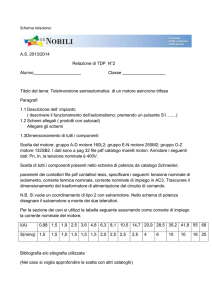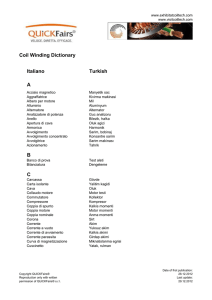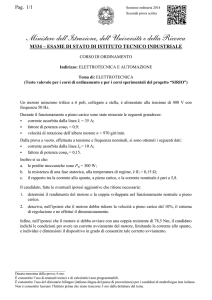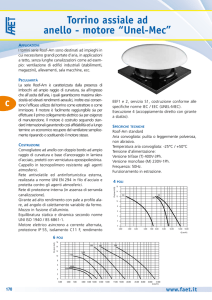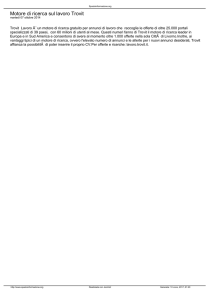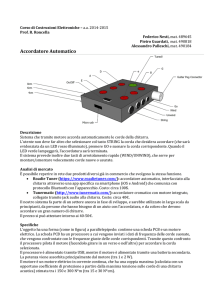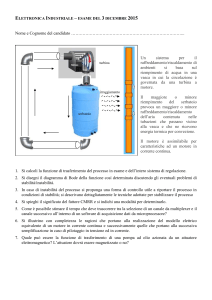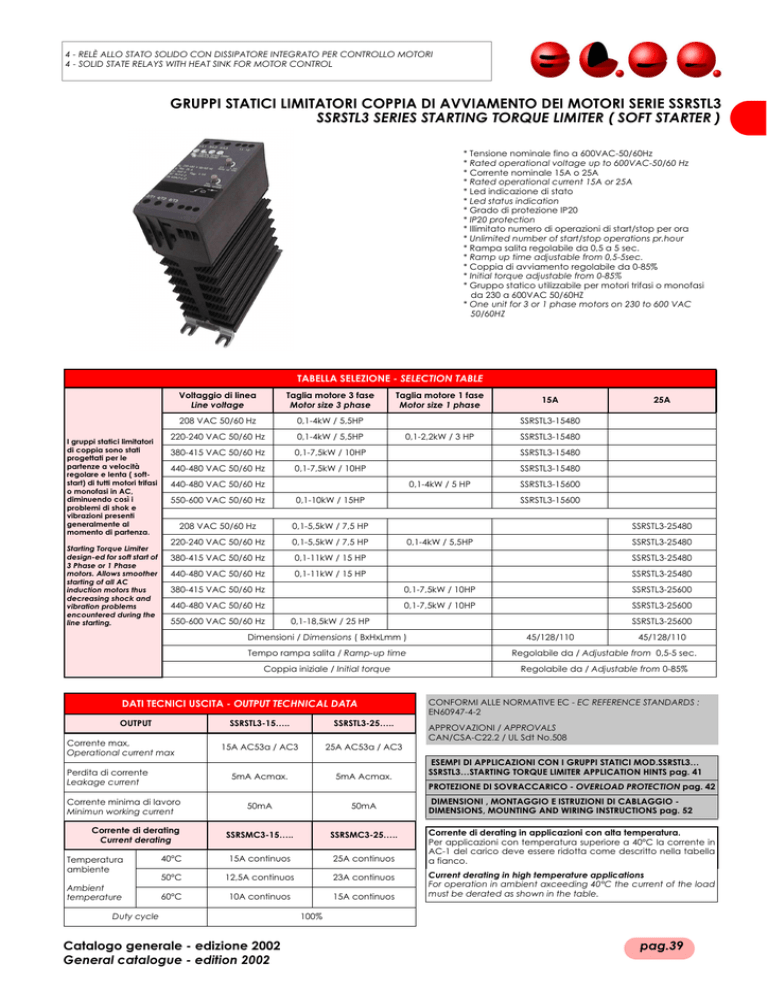
4 - RELÈ ALLO STATO SOLIDO CON DISSIPATORE INTEGRATO PER CONTROLLO MOTORI
4 - SOLID STATE RELAYS WITH HEAT SINK FOR MOTOR CONTROL
GRUPPI STATICI LIMITATORI COPPIA DI AVVIAMENTO DEI MOTORI SERIE SSRSTL3
SSRSTL3 SERIES STARTING TORQUE LIMITER ( SOFT STARTER )
* Tensione nominale fino a 600VAC-50/60Hz
* Rated operational voltage up to 600VAC-50/60 Hz
* Corrente nominale 15A o 25A
* Rated operational current 15A or 25A
* Led indicazione di stato
* Led status indication
* Grado di protezione IP20
* IP20 protection
* Illimitato numero di operazioni di start/stop per ora
* Unlimited number of start/stop operations pr.hour
* Rampa salita regolabile da 0,5 a 5 sec.
* Ramp up time adjustable from 0,5-5sec.
* Coppia di avviamento regolabile da 0-85%
* Initial torque adjustable from 0-85%
* Gruppo statico utilizzabile per motori trifasi o monofasi
da 230 a 600VAC 50/60HZ
* One unit for 3 or 1 phase motors on 230 to 600 VAC
50/60HZ
TABELLA SELEZIONE - SELECTION TABLE
I gruppi statici limitatori
di coppia sono stati
progettati per le
partenze a velocità
regolare e lenta ( softstart) di tutti motori trifasi
o monofasi in AC,
diminuendo così i
problemi di shok e
vibrazioni presenti
generalmente al
momento di partenza.
Starting Torque Limiter
design-ed for soft start of
3 Phase or 1 Phase
motors. Allows smoother
starting of all AC
induction motors thus
decreasing shock and
vibration problems
encountered during the
line starting.
Voltaggio di linea
Line voltage
Taglia motore 3 fase
Motor size 3 phase
208 VAC 50/60 Hz
0,1-4kW / 5,5HP
Taglia motore 1 fase
Motor size 1 phase
15A
SSRSTL3-15480
220-240 VAC 50/60 Hz
0,1-4kW / 5,5HP
380-415 VAC 50/60 Hz
0,1-7,5kW / 10HP
SSRSTL3-15480
440-480 VAC 50/60 Hz
0,1-7,5kW / 10HP
SSRSTL3-15480
0,1-2,2kW / 3 HP
440-480 VAC 50/60 Hz
0,1-4kW / 5 HP
550-600 VAC 50/60 Hz
0,1-10kW / 15HP
208 VAC 50/60 Hz
0,1-5,5kW / 7,5 HP
220-240 VAC 50/60 Hz
0,1-5,5kW / 7,5 HP
380-415 VAC 50/60 Hz
0,1-11kW / 15 HP
440-480 VAC 50/60 Hz
0,1-11kW / 15 HP
25A
SSRSTL3-15480
SSRSTL3-15600
SSRSTL3-15600
SSRSTL3-25480
0,1-4kW / 5,5HP
SSRSTL3-25480
SSRSTL3-25480
SSRSTL3-25480
380-415 VAC 50/60 Hz
0,1-7,5kW / 10HP
SSRSTL3-25600
440-480 VAC 50/60 Hz
0,1-7,5kW / 10HP
SSRSTL3-25600
550-600 VAC 50/60 Hz
0,1-18,5kW / 25 HP
Dimensioni / Dimensions ( BxHxLmm )
SSRSTL3-25600
45/128/110
45/128/110
Tempo rampa salita / Ramp-up time
Regolabile da / Adjustable from 0,5-5 sec.
Coppia iniziale / Initial torque
Regolabile da / Adjustable from 0-85%
DATI TECNICI USCITA - OUTPUT TECHNICAL DATA
CONFORMI ALLE NORMATIVE EC - EC REFERENCE STANDARDS :
EN60947-4-2
OUTPUT
APPROVAZIONI / APPROVALS
CAN/CSA-C22.2 / UL Sdt No.508
Corrente max,
Operational current max
Perdita di corrente
Leakage current
15A AC53a / AC3
25A AC53a / AC3
5mA Acmax.
5mA Acmax.
50mA
50mA
SSRSMC3-15…..
SSRSMC3-25…..
40°C
15A continuos
25A continuos
50°C
12,5A continuos
23A continuos
60°C
10A continuos
15A continuos
Corrente di derating
Current derating
Ambient
temperature
SSRSTL3-25…..
ESEMPI DI APPLICAZIONI CON I GRUPPI STATICI MOD.SSRSTL3…
SSRSTL3…STARTING TORQUE LIMITER APPLICATION HINTS pag. 41
PROTEZIONE DI SOVRACCARICO - OVERLOAD PROTECTION pag. 42
Corrente minima di lavoro
Minimun working current
Temperatura
ambiente
SSRSTL3-15…..
Duty cycle
Catalogo generale - edizione 2002
General catalogue - edition 2002
DIMENSIONI , MONTAGGIO E ISTRUZIONI DI CABLAGGIO DIMENSIONS, MOUNTING AND WIRING INSTRUCTIONS pag. 52
Corrente di derating in applicazioni con alta temperatura.
Per applicazioni con temperatura superiore a 40°C la corrente in
AC-1 del carico deve essere ridotta come descritto nella tabella
a fianco.
Current derating in high temperature applications
For operation in ambient axceeding 40°C the current of the load
must be derated as shown in the table.
100%
pag.39
4 - RELÈ ALLO STATO SOLIDO CON DISSIPATORE INTEGRATO PER CONTROLLO MOTORI
4 - SOLID STATE RELAYS WITH HEAT SINK FOR MOTOR CONTROL
DATI TECNICI ENTRATA USCITA
INPUT / OUTPUT TECHNICAL DATA
DATI TERMICI - THERMAL DATA
Temperatura lavoro
Operating temperature
-5 ÷ 60°C
Tensione di isolamento
Rated insulation voltage
Temp. Di stoccaggio
Storage temperature
-20 ÷ 80°C
Impulso di tensione input output
Rated impulse withstand voltage
Metodo raffreddamento
Cooling method
Fissaggio
Mounting
Ui 660V
Uimp. 4kV
Naturale
Natural convection
Verticale +/-30%
Vertical +/-30%
SCHEMA DI COLLEGAMENTO - WIRING DIAGRAM
Soft-start con motore trifase o monofase
Quando il contattore elettromeccanico si ecciterà il motore partirà con la
rampa di salita e la coppia regolata con i potenziometri.Quando il contattore
elettromeccanico si disecciterà il motore si fermerà senza nessuna regolazione.
Morsetti di potenza 1/L1-2/T1&3/L2-4/T2&5/L3-6/T3. I terminali 11 e 12 non sono
collegati con il circuito interno ma servono per la connessione della protezione
termica di sovraccarico.
Three Phase or Single Phase Soft- Start
When the contactor is switched ON the motor will soft-start according to the
settings of the torque and time potentiometers.
When the contactor is switched Off the motor will stop.
Main terminals 1/L1-2/T1&3/L2-4/T2&5/L3-6/T3. Terminals 11 and 12 have no
connection with the internal circuit. Can be used in conjunction with a thermal
overload protection.
PROTEZIONE TERMICA DI SOVRACCARICO - THERMAL OVERLOAD PROTECTION
La protezione termica di sovraccarico è ottenuta inserendo un
termostato nell'apposito alloggiamento nella parte destra del
gruppo statico. Il gruppo statico accetta 2 tipi di termostati : UP6290( UCHIYA ) o P62-90 ( LIMITATOR ).
Optional thermal overload protection is achieved by inserting a
thermostat in the slot on the right hand side of the contactor.
The contactor accepts 2 types of thermostatats : UP-62-90 from
Uchiya or P62-90 from Limitator.
EMC
Questo prodotto è stato costruito e marcato CE in accordo alle normative EN60947-4-2. Questo prodotto è stato progettato per apparecchiature di
classe A. L'uso di questo prodotto in ambienti domestici può causare interferenze radio, in questo caso l'utilizzatore dovrebbe richiedere di impiegare
addizionali sistemi di attenuazione.
This component meets the requirements of the product standard EN60947-4-2 and is CE marked according to this standard. This product has been
designed for class A equipment. Use of the product in domestic environments may cause radio interference, in which case the user may be required
to employ additional mitigation methods.
COME REGOLARE LA RAMPA DI SALITA E LA COPPIA DI PARTENZA
HOW TO ADJUST TIME AND TORQUE
Il controllo della coppia del motore è realizzata regolando la
tensione del motore. La velocità dipende dal carico applicato
sull'albero del motore. Un motore con un piccolo o senza carico
raggiungerà la massima velocità prima che la tensione abbia
raggiunto il valore massimo.
Control of the motor torque is achieved by acting on the motor voltage.The motor speed depends on the load on the motor shaft.A motor
with little or no load will reach full speed before the voltage has
reached its maximum value.
DIAGRAMMA FUZIONALE - FUNCTIONAL DIAGRAM
pag.40
Catalogo generale - edizione 2002
General catalogue - edition 2002
4 - RELÈ ALLO STATO SOLIDO CON DISSIPATORE INTEGRATO PER CONTROLLO MOTORI
4 - SOLID STATE RELAYS WITH HEAT SINK FOR MOTOR CONTROL
ESEMPI DI APPLICAZIONI CON I GRUPPI STATICI MOD.SSRSTL3…
SSRSTL3…STARTING TORQUE LIMITER APPLICATION HINTS
AVVIAMENTO MOTORE SOFT-START - LINE CONTROLLED SOFT-START
Quando il contattore elettromeccanico C1 si eccita il gruppo statico
controllerà la partenza de motore ( soft-start) in corrispondenza dei valori del
tempo di rampa di salita e di coppia impostati coi trimmer. Quando il
contattore elettromeccanico C1 si disecciterà il motore si fermerà
istantaneamente.
When the contactor C1 is switched to the On-state,the motor controller will soft
start the motor according to the settings of the Ramp-Up time and initial torque
adjust- ments. When the contactor C1 is switched to the OFF-state,the motor
will be switched Off instantaneously.
AVVIAMENTO MOTORE CON SOFT-STARTER E GRUPPO STATICO PER INVERSIONE DI MARCIA
COMBINING REVERSING ELECTRONIC CONTACTOR & SOFT STARTER
FINO A MOTORI DA 4KW
Un avviamento soft-star del motore con inversione di marcia può essere
facilmente attuabile usando un gruppo statico mod.SSRSRC3….(per inversione
di marcia) con un gruppo statico mod.SSRSTL3….(avviatore statico). Il gruppo
statico mod.SSRSRC3… determinerà il senso di marcia del motore mentre il
gruppo statico mod.SSRSTL3…svolgerà la funzione di soft-start per
l'avviamento del motore.
SOFT-REVERSING OF MOTORS UP TO 4 KW
A soft-reversing of a motor can easily be achieved by connecting a reversing
relay to the Starting Torque Limiter. The reversing relay type SSRSRC3... will
determine the direction of rotation forward or reverse and the Starting Torque
Limiter type SSRSTL3 wil perform soft-starting of the motor.
AVVIAMENTO MOTORE CON SOFT-STARTER E CONTATTORI ELETTROMECCANICI PER INVERSIONE DI MARCIA
COMBINING REVERSING MECHANICAL CONTACTOR &SOFT STARTER
FINO A MOTORI DA 11KW
Un avviamento soft-star del motore con inversione di marcia può essere
facilmente attuabile, quando il motore supera i 4kW, collegando in serie al
soft-starter due contattori elettromeccanici come da figura. I contattori
elettromeccanici determineranno il senso di marcia del motore mentre il
gruppo statico mod.SSRSTL3… svolgerà la funzione di soft-start per
l'avviamento del motore.
SOFT-REVERSING OF MOTORS UP TO 11 KW
A soft-reversing of a motor can easily be achieved when the motor load
exceeds 4kW, by connecting a mechanical reversing contactor to the Soft
Starter.The reversing contactor will determine the direction of rotation Forward
or Reverse and the Starting Torque Limiter type SSRSTL3... will perform softstarting of the motor.
PROTEZIONE DI SOVRACCARICO CON SALVAMOTORE
OVERLOAD PROTECTION WITH THERMAL MAGNETIC CIRCUIT BREAKER
La protezione di sovraccarico dei motori è facilmente realizzabile installando
un salvamotore manuale in serie al motore. Il salvamotore garantisce la
protezione al sistema come un sezionatore di circuito in accordo con la
norma EN60204-1. Scegliere il tipo di salvamotore e regolarne la corrente
limite in funzione della corrente nominale del motore.
Overload protection of the motor is easily achieved by installing a manual
thermal magnetic circuit breaker on the supply side of the motor. The circuit
breaker provides means for padlocking and the necessary clearance for use
as a circuit isolator according to EN 60204-1.Select the manual circuit breaker
according to the rated current of the motor. Adjust the current limit on the MCB
according to the rated nominal current of the motor.
Catalogo generale - edizione 2002
General catalogue - edition 2002
pag.41
4 - RELÈ ALLO STATO SOLIDO CON DISSIPATORE INTEGRATO PER CONTROLLO MOTORI
4 - SOLID STATE RELAYS WITH HEAT SINK FOR MOTOR CONTROL
PROTEZIONI DA CORTO CIRCUITO - SHORT-CIRCUIT PROTECTION
a) Protezione da corto circuito con salvamotore
Un motore trifase con un salvamotore correttamente installato e regolato non permetterà un corto verso massa o tra le tre fasi del motore. Parte
dell'avvolgimento limiterà la corrente di corto circuito al valore di sgancio dell' interruttore magnetico ( salvamotore ) senza danneggiare il
semiconduttore. Il valore della corrente di sgancio é circa 11 volte la corrente regolata sull'interruttore magnetico.
a) Short-circuit protection by circuit breaker
A 3-Phase motor with correctly installed and adjusted overload relay wil not short circuit totally to earth or between the 3 phases.Part of the winding will
normally limit the short circuit current to a value that will cause instantaneous magnetic tripping of the circuit breaker without damage to the SSRSTL3.
The magnetic trip response current is approx.11 times the max.adjustable current.
b) Protezione da corto circuito con fusibili / Short circuit by fuses
SSRSTL3-15…..protection max.I²t of the fuse 1800 A²S / valore massimo I²t del fusibile 1800A²S
SSRSTL3-25….protection max.I²t of the fuse 6300 A²S / valore massimo I²t del fusibile 6300A²S
TERMOSTATI PER PROTEZIONE TERMICA DI SOVRACCARICO - THERMOSTATS FOR THERMAL OVERLOAD PROTECTION
MODELLO / MODEL
TO6290
PROTEZIONE TERMICA DI SOVRACCARICO - THERMAL OVERLOAD PROTECTION
Il termostato è connesso in serie al contattore principale.
Quando la temperatura del dissipatore supererà i 90°C/100°C il
contattore principale si disecciterà. Un reset manuale è necessario
per ripristinare il circuito.
The thermostat is connected in series with the control circuit of the
main contactor. When the temperature of the heatsink exceeds
90°C/100°C the main contactor will switch Off.A manual reset is
necessary to restart this circuit.
COME REGOLARE LA RAMPA DI SALITA E LA COPPIA DI PARTENZA
HOW TO ADJUST TIME AND TORQUE
Il controllo della coppia del motore è realizzata regolando la
tensione del motore. La velocità dipende dal carico applicato
sull'albero del motore. Un motore con un piccolo o senza carico
raggiungerà la massima velocità prima che la tensione abbia
raggiunto il valore massimo.
Control of the motor torque is achieved by acting on the motor volt
ge.The motor speed depends on the load on the motor shaft.A motor
with little or no load will reach full speed before the voltage has
reached its maximum value.
N.B. :
Il gruppo statico rileva il tempo per la rampa di salita e il valore di coppia quando si trova allo stato di OFF. Ripetute partenze potrebbero far scattare
il relè di protezione del motore.
Please note:
The Starting Torque Limiter will read time and torque settings in the off state. Repeated starts may trip the motor protection relay.
A- Regolazione della rampa di salita
A- Ramp-Up time adjustment (Standard Load)
B- Regolazione della coppia
B- Initial Torque adjustment (Standard Load)
A1) Regolare il trimmer della rampa di salita al
valore massimo
B2) Regolare il trimmer della coppia al valore
minimo.
A1) Set the Ramp-Up potentiometer to maximum
B2) Set the Initial torque switch to minimum.
A4) Diminuire il trimmer fino ad ottenere il valore
desiderato della rampa di partenza.
B3) Commutare in ON per un piccolo tempo il
gruppo statico.Se il carico applicato al motore
non si muove immediatamente incrementare il
trimmer per la regolazione della coppia e
riprovare a ridare la marcia al motore. Ripetere
le operazioni sopra descritte fino a quando il
motore
non
incomincerà
a
muoversi
immediatamente ogni start del gruppo statico.
A4) Decrease the Ramp-Up time until the desired
start is achieved
B3) Switch the contactor ON for a short time.If the
load does not rotate immediately increment the
Initial torque and try again.Repeat until the load
starts to rotate immediately on Start-Up.
pag.42
Catalogo generale - edizione 2002
General catalogue - edition 2002

